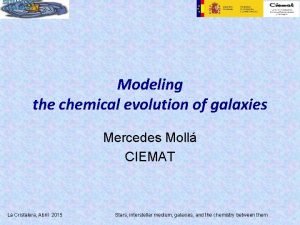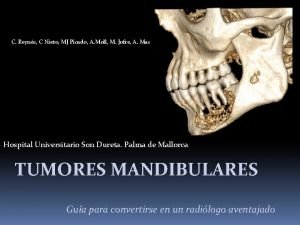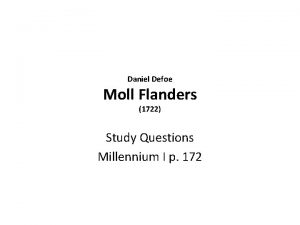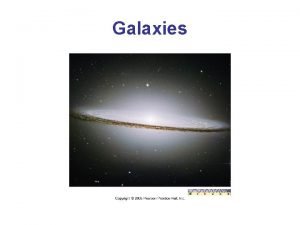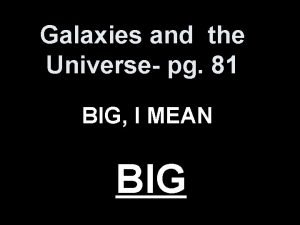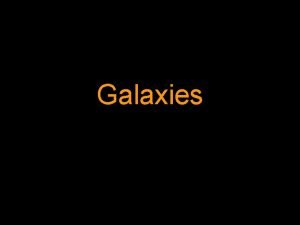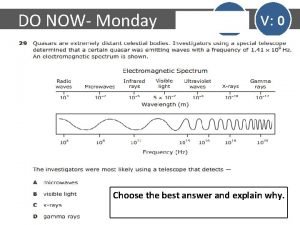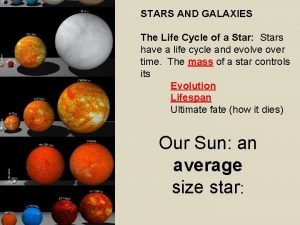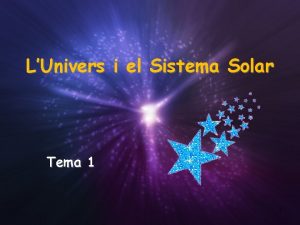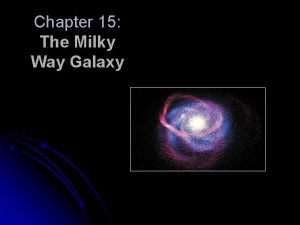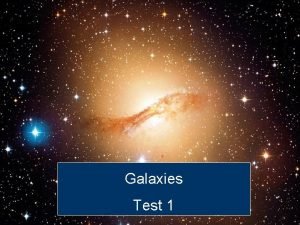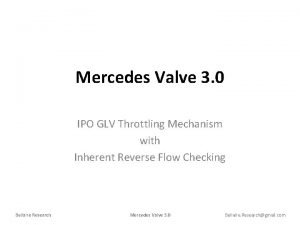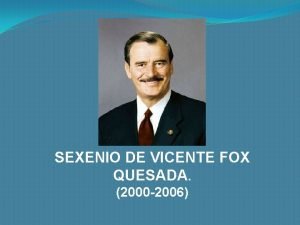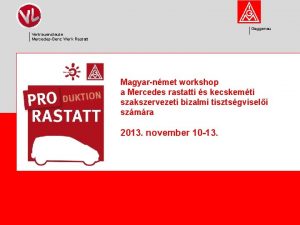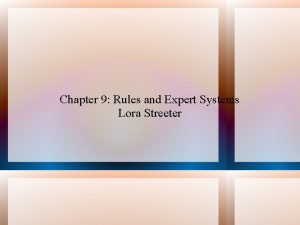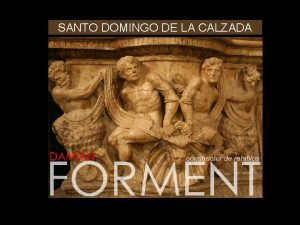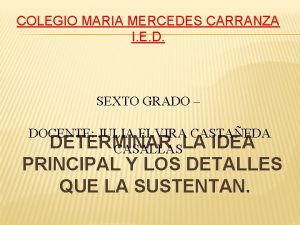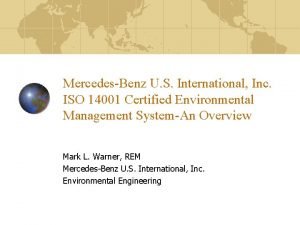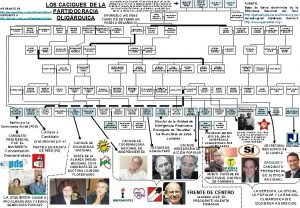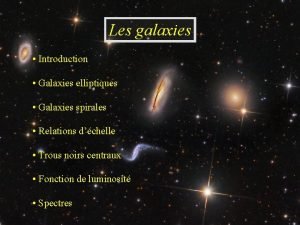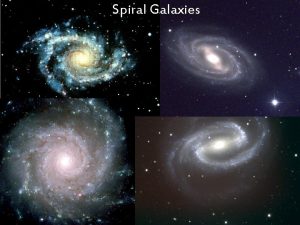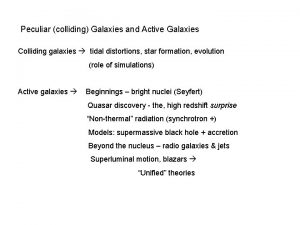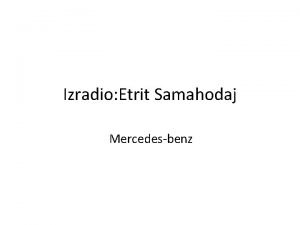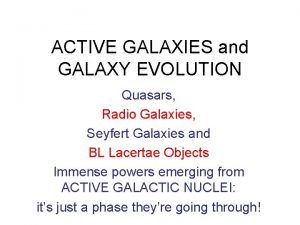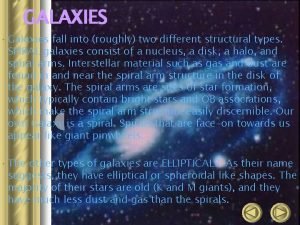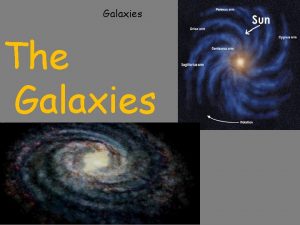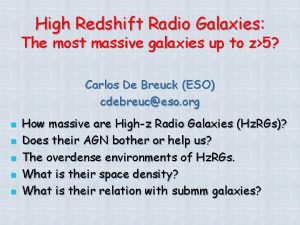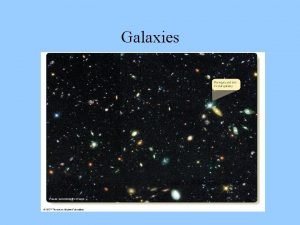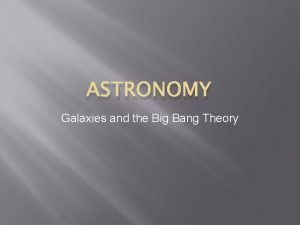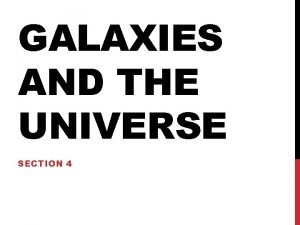Modeling the chemical evolution of galaxies Mercedes Moll
















































- Slides: 48

Modeling the chemical evolution of galaxies Mercedes Mollá CIEMAT La Cristalera, Abril 2015 Stars, interstellar medium, galaxies, and the chemistry between them

Angeles y mis inicios en Astronomía Trabajando en el CSN…evaluando centrales nucleares…. y cuidando niños! La Cristalera, Abril 2015 Las funciones del Consejo de Seguridad Nuclear son las de evaluación y control de la seguridad de las instalaciones, en todas y en cada una de las etapas en la vida de una central (diseño, construcción, pruebas, operación y clausura). Controla y vigila los niveles de radiactividad dentro y fuera de las instalaciones, tanto nucleares como radiactivas, y vela por la protección de las personas el medio ambiente. Stars, radiológica interstellar medium, galaxies, and theychemistry between them

Galaxies Chemical Evolution Aim Chemical elements are created and then: § Ejected and diluted in the interstellar medium § Incorporated to the sucessive generations of stars Elemental abundances give clues about star formation: when, how, with which rate stars form • Phases: –to understand processes, –to predict elemental abundances, –to compare with data GCE tries to explain how and when the elements appear From elemental abundances we may deduce the evolutionary histories of galaxies La Cristalera, Abril 2015

A) Tinsley 1981: El modelo simple 1)The system will have 2 types of stars q those with mass m>m 1 with t� 0 dying when form q those with m< m 1 and t= If 2) The system is closed f=0 3) Metals are instantaneously mixed with the ISM Model predictions: 1. Abundance proportional to the total yield of one stellar generation 2. This relation abundance-yield is independent of the star formation history or the star formation rate Model problems: 1. The G-dwarf metallicity distribution is not reproduced 2. The relation not sufficient to obtain the observed radial gradient of abundances La Cristalera, Abril 2015 Stars, interstellar medium, galaxies, and the chemistry between them

A) Tinsley 1981: El modelo simple 1)The system will have 2 types of stars q those with mass m>m 1 with t� 0 dying when form q those with m< m 1 and t= If 2) The system is closed f=0 3) Metals are instantaneously mixed with the ISM Model predictions: • El modelo simple no vale 1. Abundance proportional to the total yield of one stellar generation 2. This relation abundance-yield is independent of the star formation history or the star formation rate Model problems: 1. The G-dwarf metallicity distribution is not reproduced 2. The relation not sufficient to obtain the observed radial gradient of abundances La Cristalera, Abril 2015 Stars, interstellar medium, galaxies, and the chemistry between them

A) Tinsley 1981: El modelo simple 1)The system will have 2 types of stars q those with mass m>m 1 with t� 0 dying when form q those with m< solutions: m 1 and t= Posible If 2) The system is closed f=0 1. Infall of enriched (or not) gas 2. Metallicity dependent yields 3. Radial flows which dilute or enrich the gas of the region 4. Star formation law which varies with the radial disc 3) Metals are instantaneously mixed with the ISM Model predictions: • El modelo simple no vale 1. Abundance proportional to the total yield of one stellar generation 2. This relation abundance-yield is independent of the star formation history or the star formation rate Model problems: 1. The G-dwarf metallicity distribution is not reproduced 2. The relation not sufficient to obtain the observed radial gradient of abundances La Cristalera, Abril 2015 Stars, interstellar medium, galaxies, and the chemistry between them

A) Tinsley 1981 B) Modelo de evolución química de Angeles y Mónica 1) Díaz & Tosi, 1984 2) Tosi & Díaz, 1985 3) Díaz & Tosi, 1986 4) Tosi & Díaz, 1990 • • El modelo simple no vale Las abundancias relativas de elementos nos sirven de “reloj” The meanlifetimes of different stars explain the relative abundances of elements Cycle pp: low mass stars m<4 Mo Cycle pp+CNO: intermediate mass stars 4 Mo< m < 8 Mo Cycle CNO+ capture : massive stars m > 8 Mo • • Low mass stars produce He and C 12 Intermediate mass stars produce C, N and O Massive stars produce O, Ne, Mg, S. . , N, and Fe Binary Systems, SNIa Fe La Cristalera, Abril 2015 Stars, interstellar medium, galaxies, and the chemistry between them

A) Tinsley 1981 B) Modelo de evolución química de Angeles y Mónica 1) Díaz & Tosi, 1984 2) Tosi & Díaz, 1985 3) Díaz & Tosi, 1986 4) Tosi & Díaz, 1990 • • • La Cristalera, Abril 2015 El modelo simple no vale Las abundancias relativas de elementos nos sirven de “reloj” Los gradientes de abundancia, relación con la formación de los discos Stars, interstellar medium, galaxies, and the chemistry between them

A) Tinsley 1981 B) Modelo de evolución química de Angeles y Mónica 1) Díaz & Tosi, 1984 2) Tosi & Díaz, 1985 3) Díaz & Tosi, 1986 4) Tosi & Díaz, 1990 • • La Cristalera, Abril 2015 El modelo simple no vale Las abundancias relativas de elementos nos sirven de “reloj” Los gradientes de abundancia, relación con la formación de los discos El H 2 es realmente de donde se forman las estrellas Stars, interstellar medium, galaxies, and the chemistry between them

La evolución temporal del gradiente de abundancias: El gradiente se va creando con el tiempo Mollá et al. (1992) Ferrini et al. (1994) La Cristalera, Abril 2015 La evolución temporal del gradiente de abundancias: El gradiente se va aplanando con el tiempo Stars, interstellar medium, galaxies, and the chemistry between them

La temporal del gradiente de Enevolución el modelo D&T, el disco abundancias: El gradiente se va está creandoformado con el tiempodesde el t=0 y el infall de Z=0 solo diluye lo que se crea en el disco Mollá et al. (1992) Ferrini et al. (1994) La Cristalera, Abril 2015 En el caso de Ferrini et al, La evolución temporal del gradiente de el infall forma el disco a abundancias: El gradiente se va medidad cae de manera aplanando conque el tiempo que el material del que han de formarse las estrellas va apareciendo poco a poco Stars, interstellar medium, galaxies, and the chemistry between them

DATA IN THE MWG In the MWG we had some data from objects of different age to compare the radial gradients at other times: • Planetary Nebulae from different mass stars • Open Clusters of different ages • Globular Clusters of old ages Large uncertainties in the determination of mass, or age La Cristalera, Abril 2015 Stars, interstellar medium, galaxies, and the chemistry between them

THE TIME EVOLUTION OF THE RADIAL GRADIENT IN OTHER SPIRAL GALAXIES This variation of the radial gradient also occurs in other spiral galaxies. The rate of flattening depends on the type or size of the galaxy: • A bright-early-massive spiral galaxy shows a flat gradient which evolved very rapidly; • A low mass-late galaxy maintains a steep gradient for a longer time La Cristalera, Abril 2015 Stars, interstellar medium, galaxies, and the chemistry between them

THE GRID OF MODELS FROM MOLLÁ & DÍAZ (2005) • Mollá & Díaz (2005): a grid of chemical evolution models depending on the galaxy total mass and on the efficiency of star formation rate • Radial distributions of mass calculated from the Universal Rotation Curve from Persic, Salucci & Steel (1996) • Efficiencies to form molecular gas and stars changed simultaneously: each N defined a set ( m, H) • A by-parametric grid of 44 radial mass distributions, defined by the rotation velocity, (Vrot 30 to 300 km/s) and 10 values of N ( m, H in the range [0, 1]), were calculated, with the corresponding radial distributions of abundances, stars and gas densities and star formation rates. • Results (radial distributions of gas, abundances, star formation. . . ), and the time evolution of each radial region, were given as a function of the total mass of the galaxy for different values of efficiencies to form molecular cloud and stars La Cristalera, Abril 2015 Stars, interstellar medium, galaxies, and the chemistry between them

Ingredients of the multiphase chemical evolution model: the scenario The total mass M of each modeled galaxy and its radial distribution M(R) have been computed from the universal rotation curve V(R) from Persic, Salucci & Steel (1996) (Mollá & Díaz 2005) La Cristalera, Abril 2015 Stars, interstellar medium, galaxies, and the chemistry between them

Ingredients : The infall rate tcol a M -1/2 tcol=tcol, 0 exp(R/l) • The gas collapses onto the equatorial plane and forms out the disc • Infall rate � 1/tcol • �col = f(Mgal) ---calibration with the MWG • Since �mass =f(R ), ��� (R ) La Cristalera, Abril 2015 Stars, interstellar medium, galaxies, and the chemistry between them

Inputs of the multiphase chemical evolution model: The star formation law Star formation in the halo: SFR K g 1. 5 Stars form through cloud-cloud collisions: s Hc 2 In the disc molecular clouds form from Stars also form the diffuse gas from the interaction c mg 1. 5 between massive stars and molecular clouds: s a c s 2 La Cristalera, Abril 2015 v Every parameter changes along the galactocentric radius: § K = K (G/V)1/2 § m = m (G/Vd)1/2 § H = H cte /Vd § a = a (G rc )1/2/ <ms 2> v The efficiency a is a local parameter v The efficiency K is assumed as constant for all halos v Efficiencies m y H are variable for each galaxy Stars, interstellar medium, galaxies, and the chemistry between them

Vrot 1 30 2 40 3 48 1 2 3 4 0. 95 0. 8 0 0. 75 BCD & HII Gal. 5 6 7 8 Low mass galaxies 9 10 DDO 154 … 10 71 … 18 Normal spirals 99 … --28 200 MWG … 39 291 … M 33 M 31 Starbursts Low surface brightness Galaxies 43 44 387 La Cristalera, Abril 2015 Stars, interstellar medium, galaxies, and the chemistry between them

Calibration: the model against the Solar Vicinity data Gavilán et al. 2005, 2006 • • The age-metallicity relation and the star formation history for the solar region The metallicity distribution does not show the G-dwarf problem La Cristalera, Abril 2015 Stars, interstellar medium, galaxies, and the chemistry between them

Calibration: the model for MWG (Gavilán et al. 2005, 2006) The model: Vrot=200 km/s and N=4 against the Galactic disk data and model q We can obtain separately the radial distributions of diffuse and molecular gas q The radial gradients flattens in the inner disk in agreement with data (Smartt et al. 2001) q The star formation rate surface density is underestimated in the inner radii La Cristalera, Abril 2015 Stars, interstellar medium, galaxies, and the chemistry between them


The evolution of the abundance radial distributions along z Flat radial gradients for low evolved galaxies, and for the most evolved galaxies The inner radial distributions flatten compared with the discs Our models show a maximum oxygen abundance 12+log(O/H)~8. 9 - 9. 0 (Pilyugin et al) There is also a minimum abundance La Cristalera, Abril 2015 Stars, interstellar medium, galaxies, and the chemistry between them

The time evolution of the radial gradient of oxygen abundances Mollá 2014 La Cristalera, Abril 2015 Stars, interstellar medium, galaxies, and the chemistry between them

Vrot 1 30 2 40 3 48 1 2 3 4 0. 95 0. 8 0 0. 75 BCD & HII Gal. 5 6 7 8 Low mass galaxies 9 10 DDO 154 … 10 71 … 18 Normal spirals 99 … --28 200 MWG … 39 291 … M 33 M 31 Starbursts Low surface brightness Galaxies 43 44 387 La Cristalera, Abril 2015 Stars, interstellar medium, galaxies, and the chemistry between them

EVOLUTIONARY SYNTHESIS MODELS From the evolutionary histories and using evolutionary synthesis models, we obtained the spectral energy distributions, magnitudes and colors, brightness profiles and spectral absorption lines along the galactocentric radius for every galaxy model. La Cristalera, Abril 2015 Stars, interstellar medium, galaxies, and the chemistry between them

SEDs and colors for our galaxy models: Buzzoni (2005) Boselli(2003) La Cristalera, Abril 2015 Stars, interstellar medium, galaxies, and the chemistry between them

SUMMARY OF MODELS GRID q q q We have used the universal rotation curve from Persic, Salucci & Steel (1996) to calculate radial mass distribucions M (R) We have computed the collapse time scale for each distribution from the relation tcol, gal / tcol, MWG = (M MWG/Mgal )0. 5 We have found analytical expressions for m (T) y h (T) We compute models for 44 radial mass distributions, and 10 different values of eficiencies ( m , H) between 0 and 1, as it corresponds to their probability meaning, for each one = 440 different models The results of this bi-parametric grid can be applied to any spiral or irregular galaxy of given rotation velocity or total mass in order to estimate its evolution La Cristalera, Abril 2015 Stars, interstellar medium, galaxies, and the chemistry between them

HOWEVER • Although the radial gradient of abundances is well reproduced in the models, our results depend on the fitting of gas stars and star formation profiles… • . . and the molecular gas and the star formation rate show radial distributions decreasing in the inner disk, at variance of observed. They are not well tuned compared with observations • It. seems that we need a slower evolution… WE NEED BETTER MODELS La Cristalera, Abril 2015 Stars, interstellar medium, galaxies, and the chemistry between them

Calibration: the model for MWG (Gavilán et al. 2005, 2006) The model: Vrot=200 km/s and N=4 against the Galactic disk data and model q We can obtain separately the radial distributions of diffuse and molecular gas q The radial gradients flattens in the inner disk in agreement with data (Smartt et al. 2001) q The star formation rate surface density is underestimated in the inner radii La Cristalera, Abril 2015 Stars, interstellar medium, galaxies, and the chemistry between them

New grid of models: updating the inputs and assumptions • Radial distributions computed following equations from Salucci et al. (2007) defined in terms of Mvir and arriving to longer distances along the galactocentric radius • Collapse time-scale modified to follow the prescriptions from Shankar et al. (2006) about the observed ratio Mdisk/Mhalo • New grid of models: 75 radial mass distributions, –Mvir ∈[5 1010 -1013] Msun –Mdisk ∈ [1. 25 108 -5. 3 1011] Msun –Vrot ∈ [42 -320] km/s • Radial dependence (R) smoother than the old one. • Efficiencies M and H selected independently: 10 values in the range [0 --1] • Revision of new set of stellar yields and different IMFs La Cristalera, Abril 2015 Stars, interstellar medium, galaxies, and the chemistry between them

Ingredients of the multiphase chemical evolution model: the scenario The total mass M of each modeled galaxy and its radial distribution M(R) have been computed from the universal rotation curve V(R) from Salucci (2007) La Cristalera, Abril 2015 Stars, interstellar medium, galaxies, and the chemistry between them

Ingredients : The infall rate col M - /2 • The gas collapses onto the equatorial plane and forms out the disc • Infall rate 1/ col • col = f(Mgal) ---calibration with the MWG • Since mass =f(R ), following Shankar et al. La Cristalera, Abril 2015 Stars, interstellar medium, galaxies, and the chemistry between them

THE INFALL RATE HISTORY IN MOLLA + 2015 La Cristalera, Abril 2015 Stars, interstellar medium, galaxies, and the chemistry between them

Calibration of the MWG The MWG model: • Ndis=68, Mdyn=1012 M 0 Mdisk=6. 51010 M 0 Ropt=12 kpc La Cristalera, Abril 2015 Stars, interstellar medium, galaxies, and the chemistry between them • N( M)=4, N( H)=5

The evolution of the SF efficiency measured as SFR/MH 2 along the redshift La Cristalera, Abril 2015 Stars, interstellar medium, galaxies, and the chemistry between them

La Cristalera, Abril 2015 Stars, interstellar medium, galaxies, and the chemistry between them

THE GRID OF MODELS FROM MOLLÁ ET AL (2015) The evolution of the radial gradient is smoother than in MD 05 La Cristalera, Abril 2015 Stars, interstellar medium, galaxies, and the chemistry between them

La Cristalera, Abril 2015 Stars, interstellar medium, galaxies, and the chemistry between them

Molla & Díaz 2005 La Cristalera, Abril 2015 Stars, interstellar medium, galaxies, and the chemistry between them

La Cristalera, Abril 2015 Stars, interstellar medium, galaxies, and the chemistry between them

Molla & Díaz 2005 La Cristalera, Abril 2015 Stars, interstellar medium, galaxies, and the chemistry between them

The radial gradients for the same M and H and different Mvir models, when measured with normalized distances, are equivalent By observing different radial gradients with a normalized radial scale we may distinguish different efficiencies to form molecular clouds or stars in galaxies La Cristalera, Abril 2015 Stars, interstellar medium, galaxies, and the chemistry between them

• APRENDI CON ANGELES MUCHA ASTRONOMIA…. Y MUCHAS OTRAS COSAS • TRABAJAR CON ANGELES HA SIDO UN PLACER…Y ESPERO QUE LO MANTENGAMOS EN EL FUTURO • GRACIAS A SU CONFIANZA EN MI, MI VIDA DIÓ UN VUELCO Y ES LO QUE ES AHORA… MIL GRACIAS, Y MUCHAS FELICIDADES, ÁNGELES!!! La Cristalera, Abril 2015 Stars, interstellar medium, galaxies, and the chemistry between them

Production of nuclei in stars: Stellar yields Burbidge, Burbidge & Hoyle 1957 § Cycle pp: low mass stars m<4 Mo § Cycle pp+CNO: intermediate mass stars 4 Mo< m < 8 Mo § Cycle CNO+ capture : massive stars m > 8 Mo • • Low mass stars produce He and C 12 Intermediate mass stars produce C, N and O Massive stars produce O, Ne, Mg, S. . , N, and Fe Binary Systems, SNIa Fe

The basic equations • • • f= flux of inflow gas (iy may be 0 ) M= total mass of the system Y SFR (star formation rate E= mass ejection rate by the stars Ms=stellar mass Mg= gas mass Each star loss mass after its stellar lifetime m, after this there is a remnant tehrefore the total ejection by all stars created in a region is: wm, and Initial mass function or number of stars in the range dm Ejected mass by a star of mass m Mass of stars created in the time (t- m) which are now dying and ejecting mass after a time m

The total yield of a stellar generation pz, m is the metal fraction ejected by a star of mass m The abundance of metals may be obtained fron this equation, which implies: 1)ZY metals which dissapear from the gas when stars form 2)Zf f mass of metals which going in to the region when the gas infall 3) Zw w is the mass of metals which dissapears with the outflow of gas 4) Ez quantity of metals ejected by stars The first part is the yield or metals newly created The second one correspond to the metals which were before, in the original gas with which the star form

Data of molecular and diffuse gas mass from Young et al (1996), show that efficiencies to form molecular clouds and stars depend on morphological type of galaxies Metal Enrichment from Hydrodynamical Simulations. El Escorial. 2010 Sept.

IMF & stellar yields: no effect on the radial gradient of abundances, only variations on the absolute values of abundances La Cristalera, Abril 2015
 Mercedes moll
Mercedes moll Evolution of galaxies
Evolution of galaxies Modeling role modeling theory
Modeling role modeling theory Relational vs dimensional data modeling
Relational vs dimensional data modeling Structure of pnp transistor
Structure of pnp transistor Define moll
Define moll Mie vode moll
Mie vode moll Modello di ebers moll
Modello di ebers moll Quiste de moll
Quiste de moll Moll flanders questions and answers
Moll flanders questions and answers Antonio iglesias gamarra
Antonio iglesias gamarra Genoveva moll briones
Genoveva moll briones Vatic project
Vatic project Escuela genoveva moll briones
Escuela genoveva moll briones Zona activa transistor
Zona activa transistor Elliptical galaxies facts
Elliptical galaxies facts Type of galaxy
Type of galaxy Chapter 30 galaxies and the universe
Chapter 30 galaxies and the universe How are galaxies classified? *
How are galaxies classified? * Th eirregulars
Th eirregulars Universe pg
Universe pg Types of galaxies
Types of galaxies Edwin hubble
Edwin hubble Galaxie s
Galaxie s Era of galaxies
Era of galaxies Brainpop galaxies quiz answers
Brainpop galaxies quiz answers Life cycle of a galaxy
Life cycle of a galaxy Tipus de galaxies
Tipus de galaxies Galaxies lesson plan
Galaxies lesson plan Most galaxies in the inner region of a large cluster are
Most galaxies in the inner region of a large cluster are 4 types of galaxies
4 types of galaxies Mercedes cano herrera
Mercedes cano herrera Valve ipo
Valve ipo Mercedes benz lízingbiztosítás
Mercedes benz lízingbiztosítás Sexenio 2000 a 2006
Sexenio 2000 a 2006 Mercedes gonzales
Mercedes gonzales 21cfr312.23
21cfr312.23 Rastatt mercedes benz werk
Rastatt mercedes benz werk Mercedes streeter
Mercedes streeter Vuesas mercedes
Vuesas mercedes Mercedes kane
Mercedes kane Mercedes perez gonzalez
Mercedes perez gonzalez Las mercedes clinic
Las mercedes clinic Colegio maria mercedes carranza
Colegio maria mercedes carranza Mercedes benz iso 14001
Mercedes benz iso 14001 Mercedes diez canseco y vargas
Mercedes diez canseco y vargas Busrit in die aand
Busrit in die aand Revolución oriental resumen
Revolución oriental resumen Mbkeyonline
Mbkeyonline
